Risk of Material Misstatement in Cochlear Limited: Auditing Report
VerifiedAdded on 2023/06/07
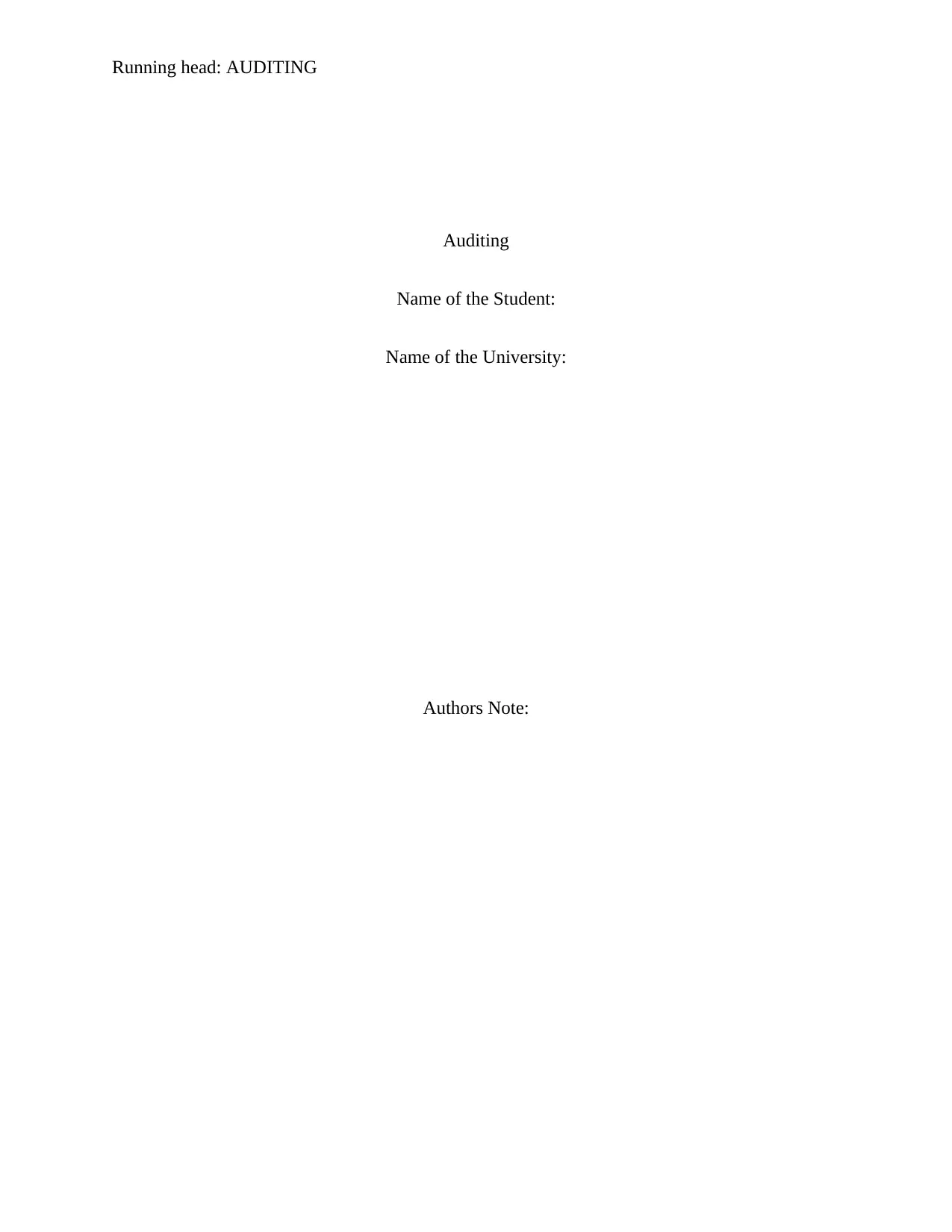
Auditing
Name of the Student:
Name of the University:
Authors Note:
Paraphrase This Document
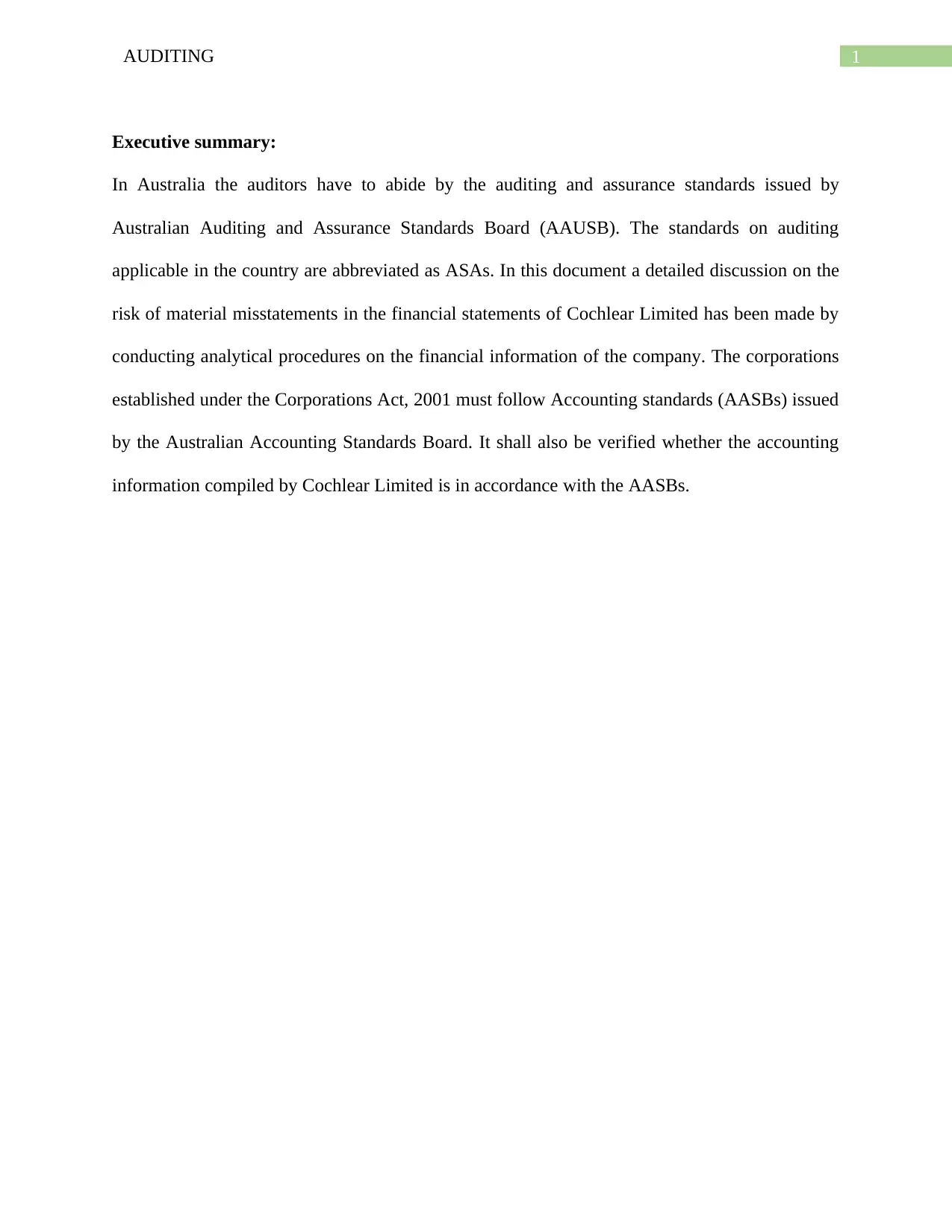
Executive summary:
In Australia the auditors have to abide by the auditing and assurance standards issued by
Australian Auditing and Assurance Standards Board (AAUSB). The standards on auditing
applicable in the country are abbreviated as ASAs. In this document a detailed discussion on the
risk of material misstatements in the financial statements of Cochlear Limited has been made by
conducting analytical procedures on the financial information of the company. The corporations
established under the Corporations Act, 2001 must follow Accounting standards (AASBs) issued
by the Australian Accounting Standards Board. It shall also be verified whether the accounting
information compiled by Cochlear Limited is in accordance with the AASBs.
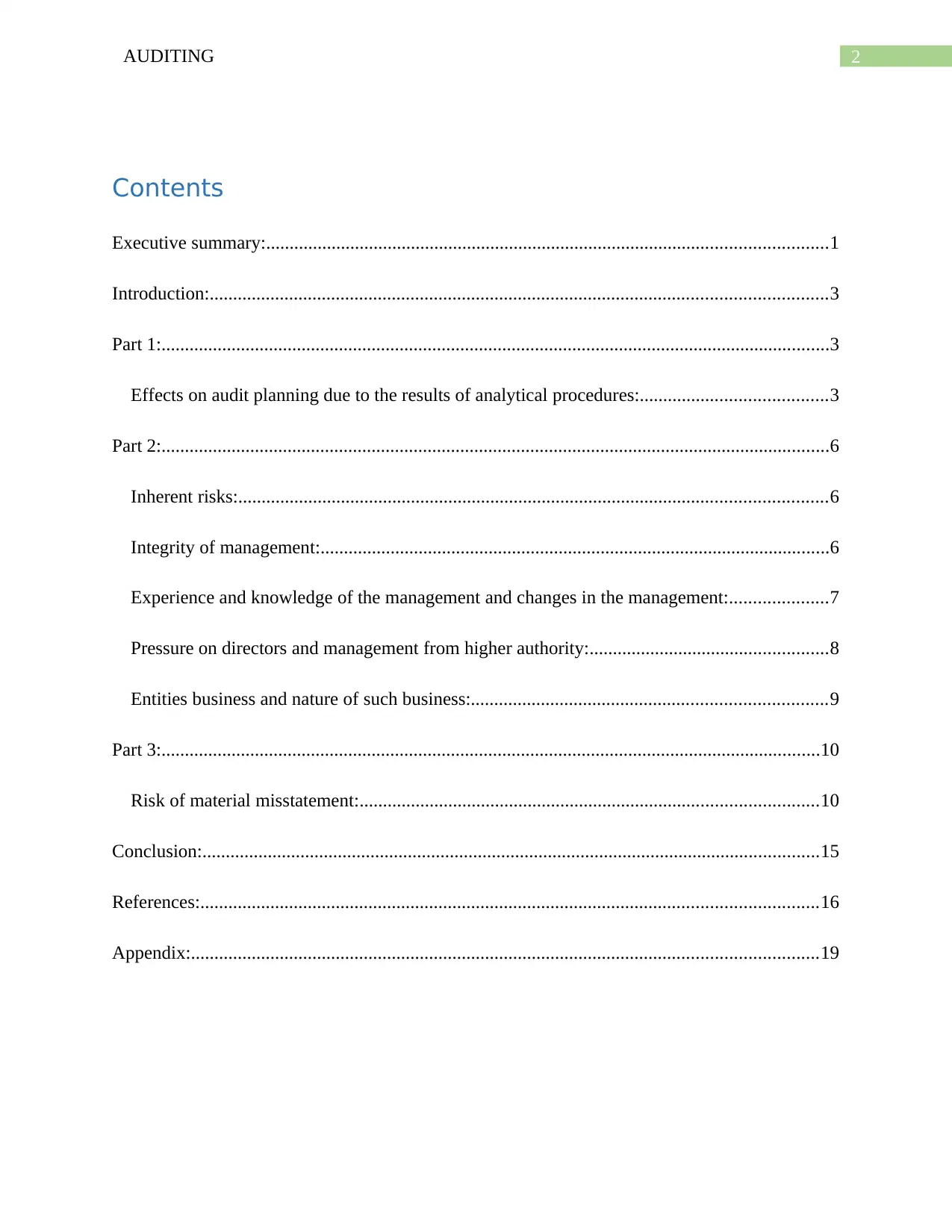
Contents
Executive summary:........................................................................................................................1
Introduction:....................................................................................................................................3
Part 1:...............................................................................................................................................3
Effects on audit planning due to the results of analytical procedures:........................................3
Part 2:...............................................................................................................................................6
Inherent risks:..............................................................................................................................6
Integrity of management:.............................................................................................................6
Experience and knowledge of the management and changes in the management:.....................7
Pressure on directors and management from higher authority:...................................................8
Entities business and nature of such business:............................................................................9
Part 3:.............................................................................................................................................10
Risk of material misstatement:..................................................................................................10
Conclusion:....................................................................................................................................15
References:....................................................................................................................................16
Appendix:......................................................................................................................................19
⊘ This is a preview!⊘
Do you want full access?
Subscribe today to unlock all pages.

Trusted by 1+ million students worldwide
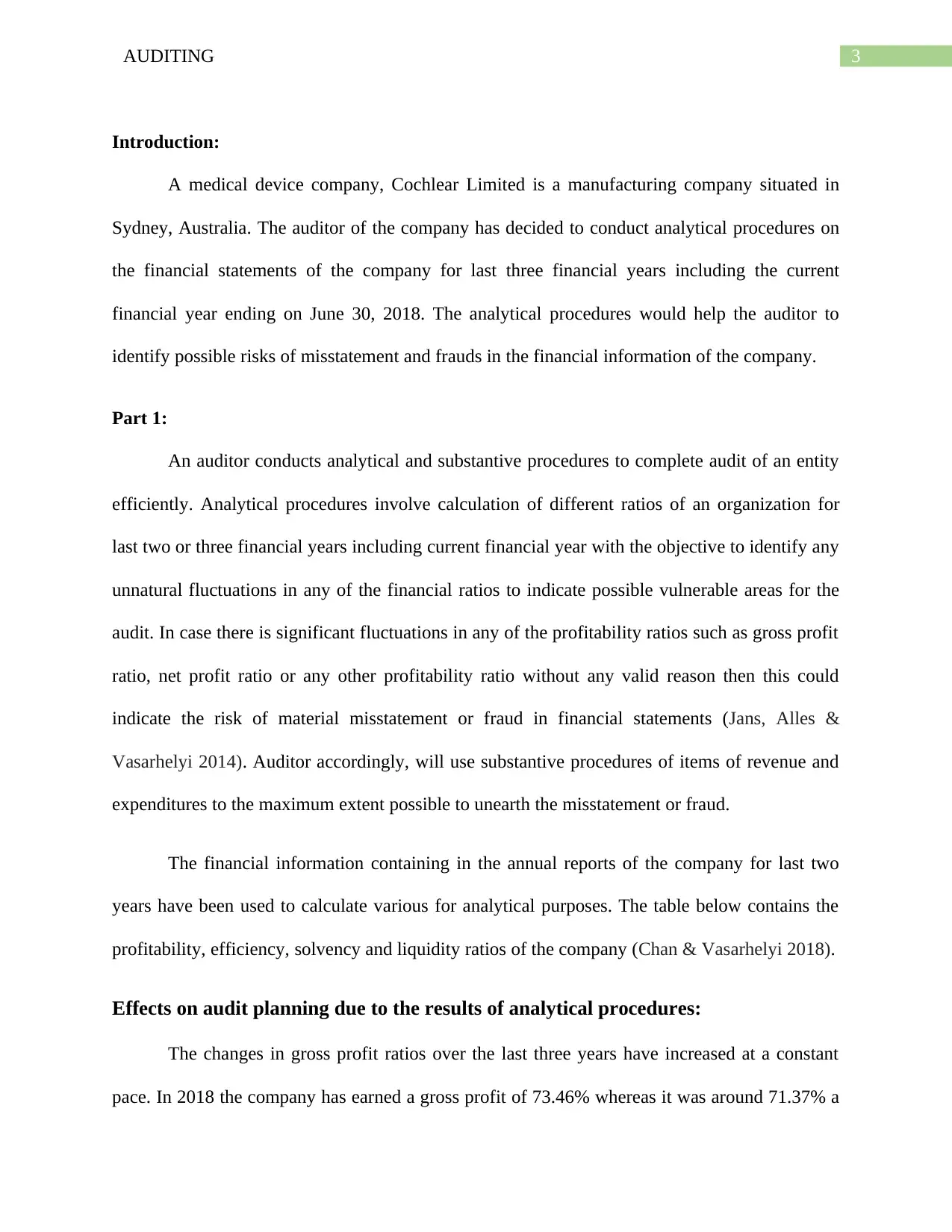
Introduction:
A medical device company, Cochlear Limited is a manufacturing company situated in
Sydney, Australia. The auditor of the company has decided to conduct analytical procedures on
the financial statements of the company for last three financial years including the current
financial year ending on June 30, 2018. The analytical procedures would help the auditor to
identify possible risks of misstatement and frauds in the financial information of the company.
Part 1:
An auditor conducts analytical and substantive procedures to complete audit of an entity
efficiently. Analytical procedures involve calculation of different ratios of an organization for
last two or three financial years including current financial year with the objective to identify any
unnatural fluctuations in any of the financial ratios to indicate possible vulnerable areas for the
audit. In case there is significant fluctuations in any of the profitability ratios such as gross profit
ratio, net profit ratio or any other profitability ratio without any valid reason then this could
indicate the risk of material misstatement or fraud in financial statements (Jans, Alles &
Vasarhelyi 2014). Auditor accordingly, will use substantive procedures of items of revenue and
expenditures to the maximum extent possible to unearth the misstatement or fraud.
The financial information containing in the annual reports of the company for last two
years have been used to calculate various for analytical purposes. The table below contains the
profitability, efficiency, solvency and liquidity ratios of the company (Chan & Vasarhelyi 2018).
Effects on audit planning due to the results of analytical procedures:
The changes in gross profit ratios over the last three years have increased at a constant
pace. In 2018 the company has earned a gross profit of 73.46% whereas it was around 71.37% a
Paraphrase This Document
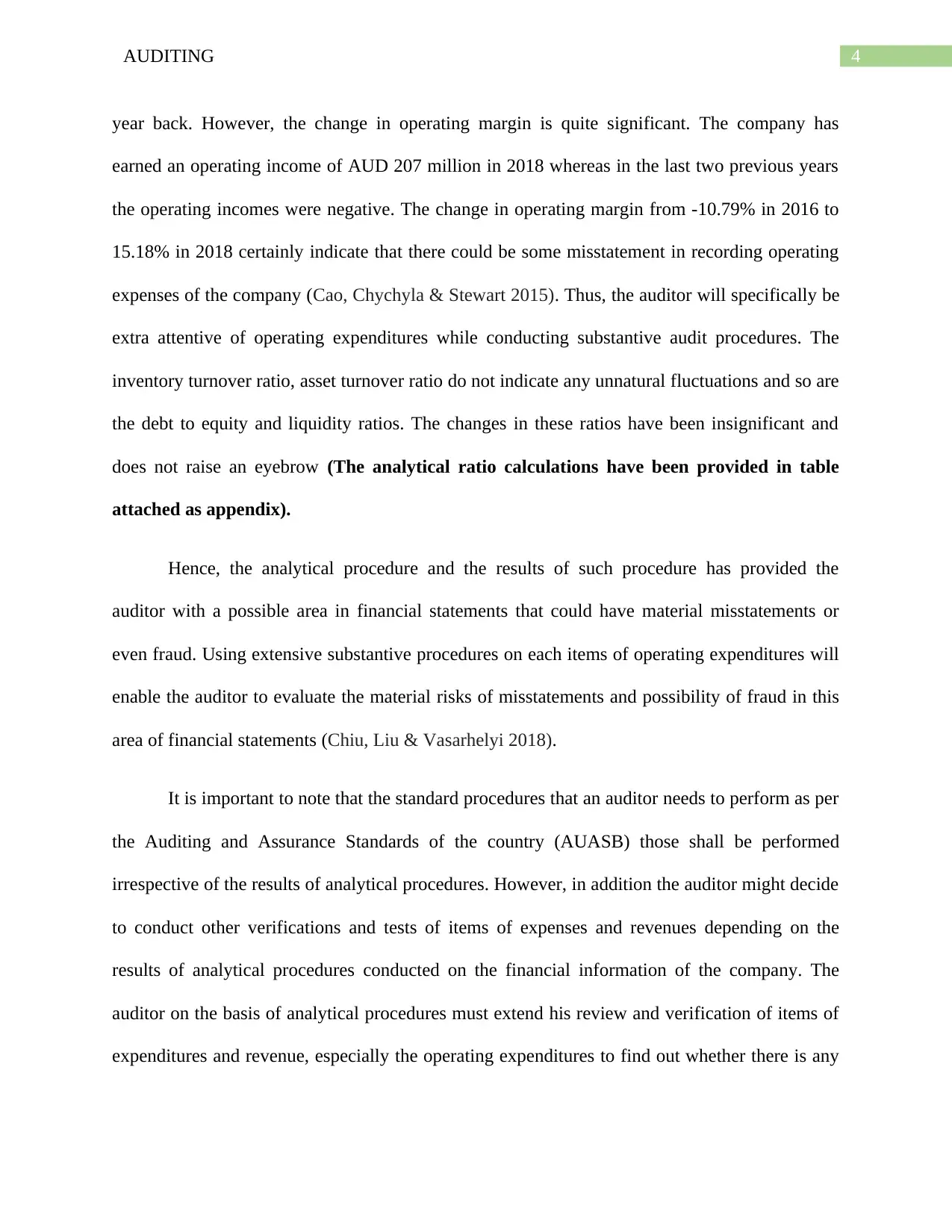
year back. However, the change in operating margin is quite significant. The company has
earned an operating income of AUD 207 million in 2018 whereas in the last two previous years
the operating incomes were negative. The change in operating margin from -10.79% in 2016 to
15.18% in 2018 certainly indicate that there could be some misstatement in recording operating
expenses of the company (Cao, Chychyla & Stewart 2015). Thus, the auditor will specifically be
extra attentive of operating expenditures while conducting substantive audit procedures. The
inventory turnover ratio, asset turnover ratio do not indicate any unnatural fluctuations and so are
the debt to equity and liquidity ratios. The changes in these ratios have been insignificant and
does not raise an eyebrow (The analytical ratio calculations have been provided in table
attached as appendix).
Hence, the analytical procedure and the results of such procedure has provided the
auditor with a possible area in financial statements that could have material misstatements or
even fraud. Using extensive substantive procedures on each items of operating expenditures will
enable the auditor to evaluate the material risks of misstatements and possibility of fraud in this
area of financial statements (Chiu, Liu & Vasarhelyi 2018).
It is important to note that the standard procedures that an auditor needs to perform as per
the Auditing and Assurance Standards of the country (AUASB) those shall be performed
irrespective of the results of analytical procedures. However, in addition the auditor might decide
to conduct other verifications and tests of items of expenses and revenues depending on the
results of analytical procedures conducted on the financial information of the company. The
auditor on the basis of analytical procedures must extend his review and verification of items of
expenditures and revenue, especially the operating expenditures to find out whether there is any

material misstatement in reporting these expenditures in the books of accounts (Abernathy,
Hackenbrack, Joe, Pevzner & Wu 2015).
The simple comparison between amount of revenue, gross profit and net income of the company
of last three years would help the auditor to make important assertion about the company and its
performance.
All amounts are in rounded off to nearest AUD million
Fiscal year ends in June. AUD in millions except per share
data.
2016-
06
2017-
06
2018-
06
Revenue 1,131.
00
1,254.
00
1,364.
00
Gross profit 797.
00
895.
00
1,002.
00
Operating income (122.
00)
(78.
00)
207.
00
Net income 189.
00
224.
00
246.
00
All the performance indicators of the company indicate that over the years the performance of
the company has improved. The revenue of the company was AUD 1,131 million in 2015-16.
This increased to AUD 1,254 million in 2016-17 and AUD 1,364 million in 2017-18. Similarly
⊘ This is a preview!⊘
Do you want full access?
Subscribe today to unlock all pages.

Trusted by 1+ million students worldwide
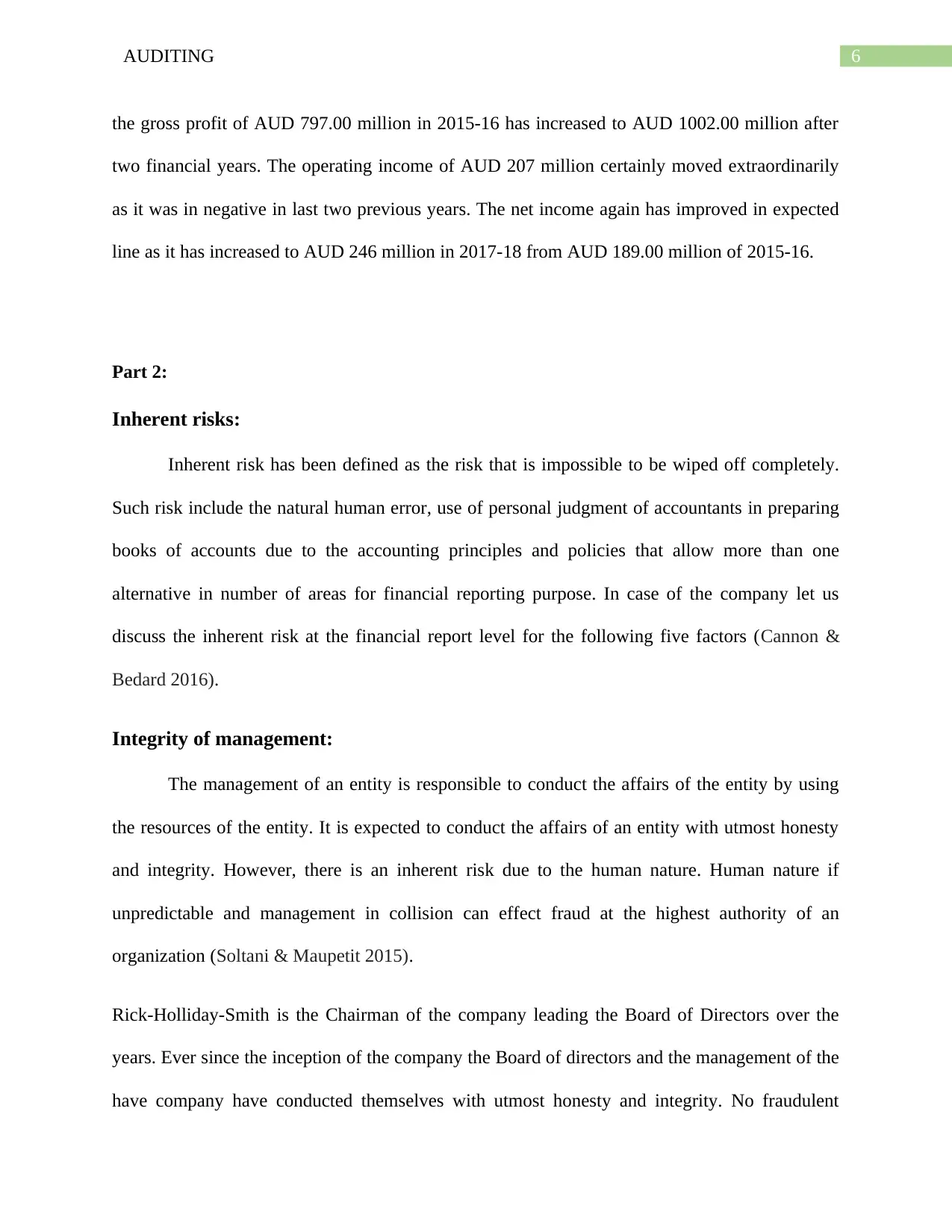
the gross profit of AUD 797.00 million in 2015-16 has increased to AUD 1002.00 million after
two financial years. The operating income of AUD 207 million certainly moved extraordinarily
as it was in negative in last two previous years. The net income again has improved in expected
line as it has increased to AUD 246 million in 2017-18 from AUD 189.00 million of 2015-16.
Part 2:
Inherent risks:
Inherent risk has been defined as the risk that is impossible to be wiped off completely.
Such risk include the natural human error, use of personal judgment of accountants in preparing
books of accounts due to the accounting principles and policies that allow more than one
alternative in number of areas for financial reporting purpose. In case of the company let us
discuss the inherent risk at the financial report level for the following five factors (Cannon &
Bedard 2016).
Integrity of management:
The management of an entity is responsible to conduct the affairs of the entity by using
the resources of the entity. It is expected to conduct the affairs of an entity with utmost honesty
and integrity. However, there is an inherent risk due to the human nature. Human nature if
unpredictable and management in collision can effect fraud at the highest authority of an
organization (Soltani & Maupetit 2015).
Rick-Holliday-Smith is the Chairman of the company leading the Board of Directors over the
years. Ever since the inception of the company the Board of directors and the management of the
have company have conducted themselves with utmost honesty and integrity. No fraudulent
Paraphrase This Document

activities have ever been reported of the directors of the Board since its inception. However, the
inherent risks of integrity of management will continue to remain due to the presence of human
element. However, the inherent risk in this regard is very low.
Experience and knowledge of the management and changes in the management:
A closer look at the annual reports of the company containing details information about
the Board of directors of the company will reveal the huge experience and talent the Board of the
company has to conduct the day to day affairs of the company. The following table contains the
information about few of the directors appointed in the Board of the company:
Name of the director Position Experience
Rick Holliday-Smith Chairman Appointed in the Board since
March 01, 2005.
Yasmin Allen Non-executive director Appointed in the Board since
August 02, 2010
Prof.. Edward Byrne Non-executive director Appointed in the Board since
July 01, 2002
Dig Howitt CEO, Preseident and MD Appointed in the Board since
in November 14, 2017
Andrew Denver Non-executive director Appointed in the Board since
February 02, 2007.
Donal O’Dwyer Non-executive director Appointed in the Board since
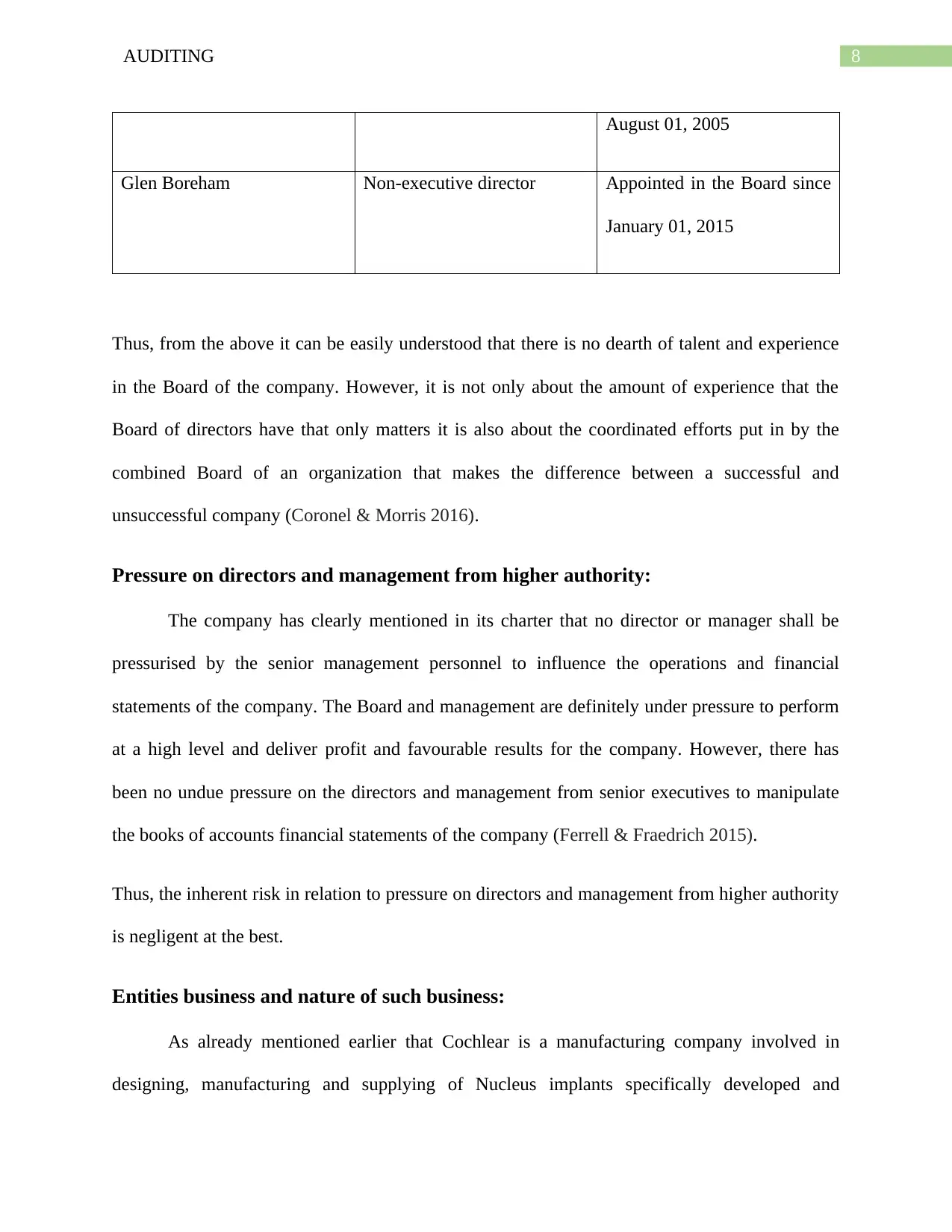
August 01, 2005
Glen Boreham Non-executive director Appointed in the Board since
January 01, 2015
Thus, from the above it can be easily understood that there is no dearth of talent and experience
in the Board of the company. However, it is not only about the amount of experience that the
Board of directors have that only matters it is also about the coordinated efforts put in by the
combined Board of an organization that makes the difference between a successful and
unsuccessful company (Coronel & Morris 2016).
Pressure on directors and management from higher authority:
The company has clearly mentioned in its charter that no director or manager shall be
pressurised by the senior management personnel to influence the operations and financial
statements of the company. The Board and management are definitely under pressure to perform
at a high level and deliver profit and favourable results for the company. However, there has
been no undue pressure on the directors and management from senior executives to manipulate
the books of accounts financial statements of the company (Ferrell & Fraedrich 2015).
Thus, the inherent risk in relation to pressure on directors and management from higher authority
is negligent at the best.
Entities business and nature of such business:
As already mentioned earlier that Cochlear is a manufacturing company involved in
designing, manufacturing and supplying of Nucleus implants specifically developed and
⊘ This is a preview!⊘
Do you want full access?
Subscribe today to unlock all pages.

Trusted by 1+ million students worldwide
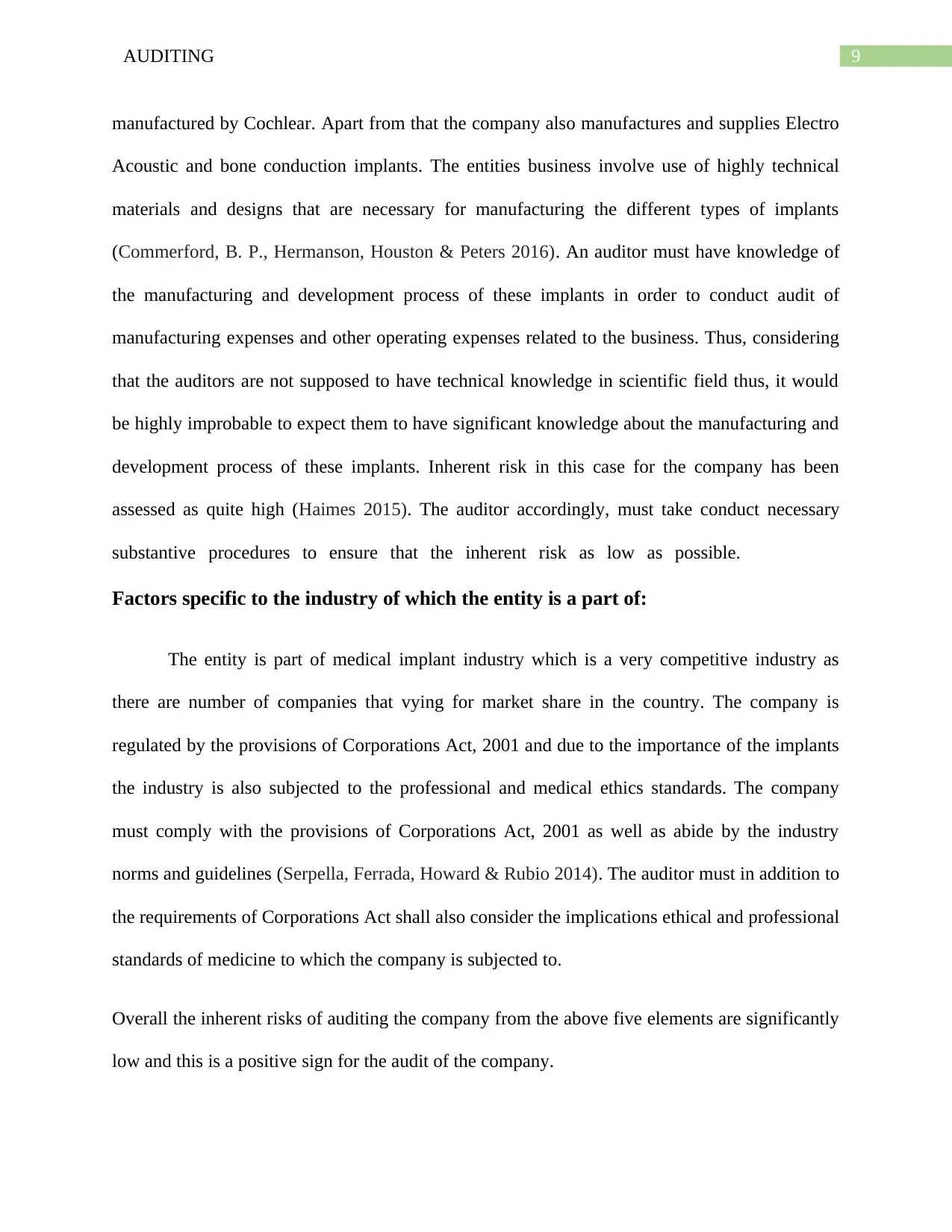
manufactured by Cochlear. Apart from that the company also manufactures and supplies Electro
Acoustic and bone conduction implants. The entities business involve use of highly technical
materials and designs that are necessary for manufacturing the different types of implants
(Commerford, B. P., Hermanson, Houston & Peters 2016). An auditor must have knowledge of
the manufacturing and development process of these implants in order to conduct audit of
manufacturing expenses and other operating expenses related to the business. Thus, considering
that the auditors are not supposed to have technical knowledge in scientific field thus, it would
be highly improbable to expect them to have significant knowledge about the manufacturing and
development process of these implants. Inherent risk in this case for the company has been
assessed as quite high (Haimes 2015). The auditor accordingly, must take conduct necessary
substantive procedures to ensure that the inherent risk as low as possible.
Factors specific to the industry of which the entity is a part of:
The entity is part of medical implant industry which is a very competitive industry as
there are number of companies that vying for market share in the country. The company is
regulated by the provisions of Corporations Act, 2001 and due to the importance of the implants
the industry is also subjected to the professional and medical ethics standards. The company
must comply with the provisions of Corporations Act, 2001 as well as abide by the industry
norms and guidelines (Serpella, Ferrada, Howard & Rubio 2014). The auditor must in addition to
the requirements of Corporations Act shall also consider the implications ethical and professional
standards of medicine to which the company is subjected to.
Overall the inherent risks of auditing the company from the above five elements are significantly
low and this is a positive sign for the audit of the company.
Paraphrase This Document
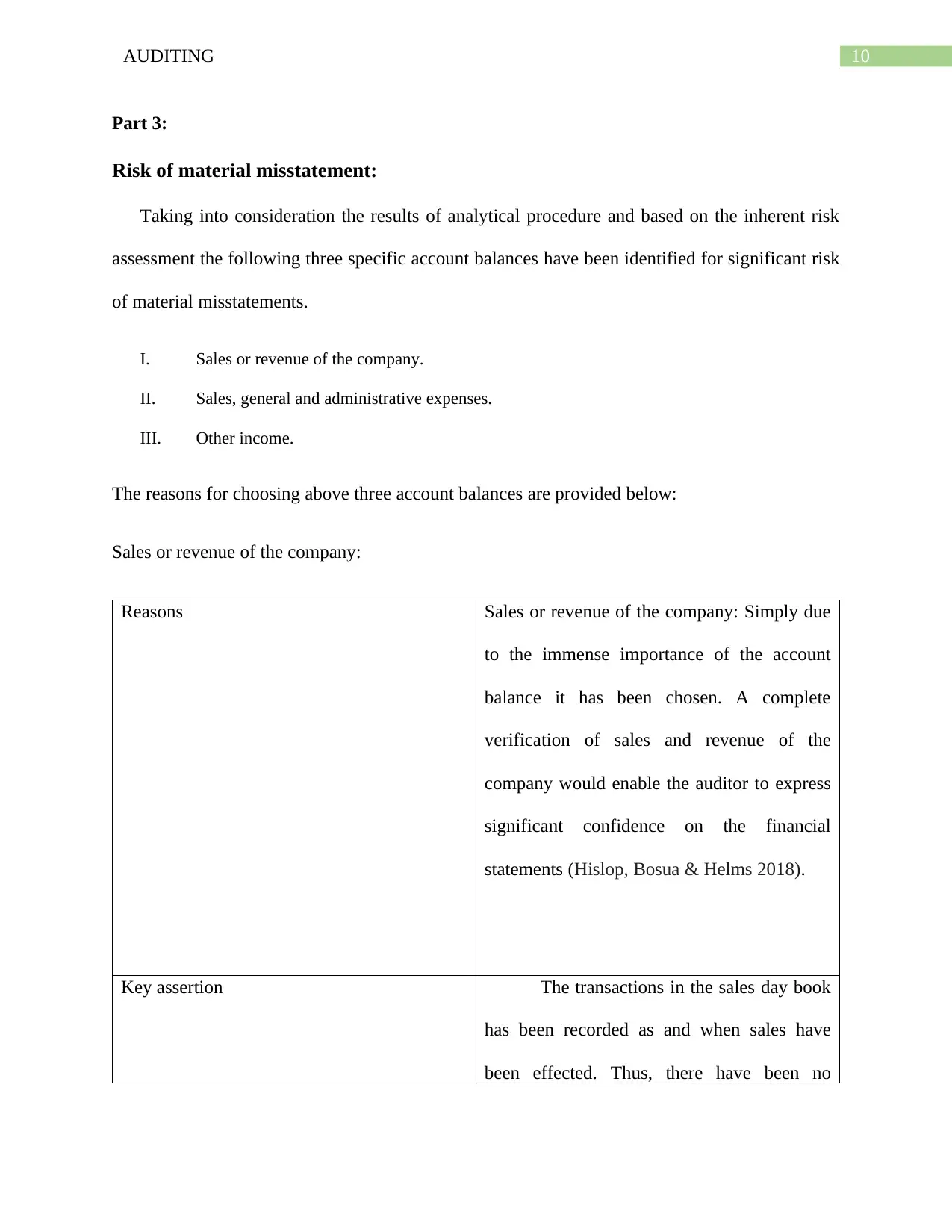
Part 3:
Risk of material misstatement:
Taking into consideration the results of analytical procedure and based on the inherent risk
assessment the following three specific account balances have been identified for significant risk
of material misstatements.
I. Sales or revenue of the company.
II. Sales, general and administrative expenses.
III. Other income.
The reasons for choosing above three account balances are provided below:
Sales or revenue of the company:
Reasons Sales or revenue of the company: Simply due
to the immense importance of the account
balance it has been chosen. A complete
verification of sales and revenue of the
company would enable the auditor to express
significant confidence on the financial
statements (Hislop, Bosua & Helms 2018).
Key assertion The transactions in the sales day book
has been recorded as and when sales have
been effected. Thus, there have been no
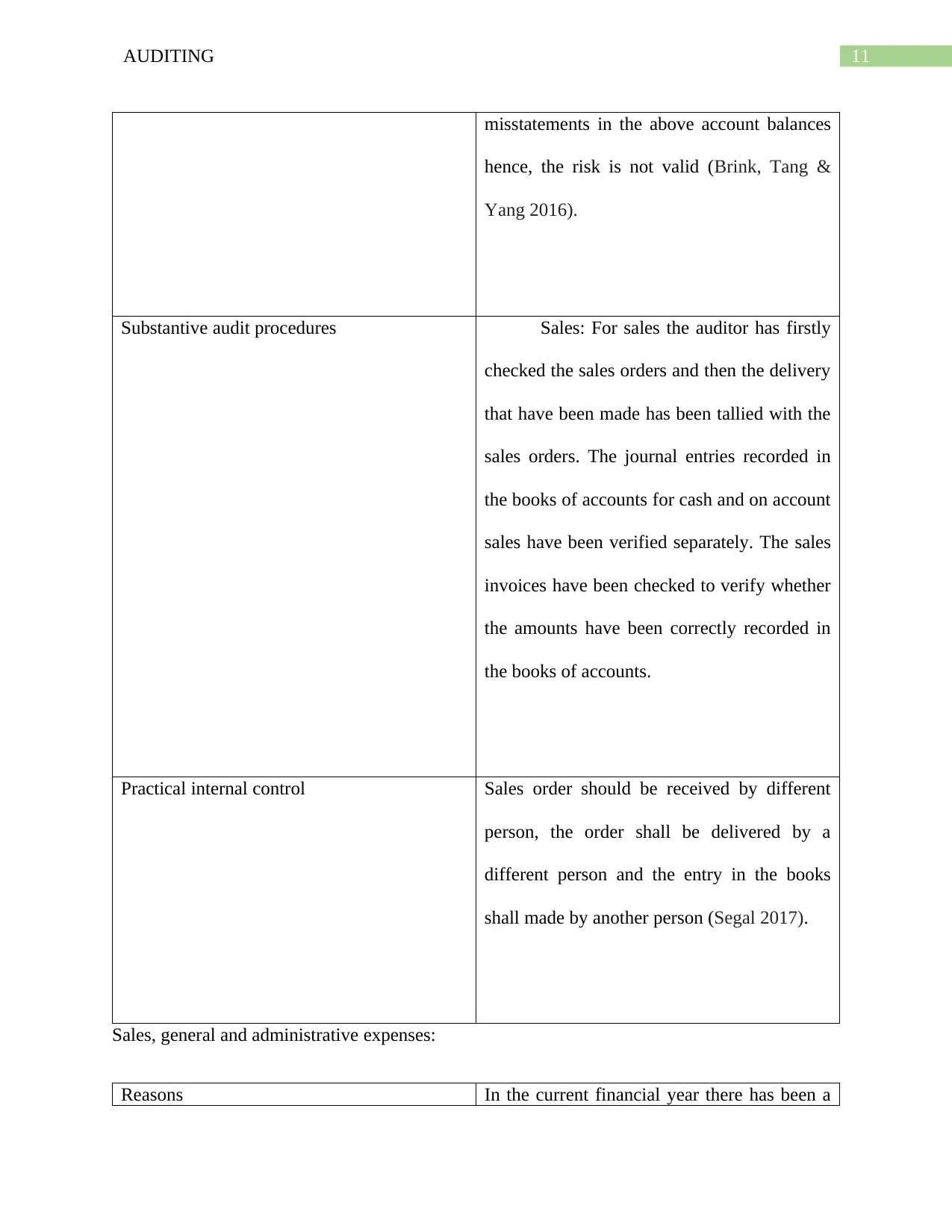
misstatements in the above account balances
hence, the risk is not valid (Brink, Tang &
Yang 2016).
Substantive audit procedures Sales: For sales the auditor has firstly
checked the sales orders and then the delivery
that have been made has been tallied with the
sales orders. The journal entries recorded in
the books of accounts for cash and on account
sales have been verified separately. The sales
invoices have been checked to verify whether
the amounts have been correctly recorded in
the books of accounts.
Practical internal control Sales order should be received by different
person, the order shall be delivered by a
different person and the entry in the books
shall made by another person (Segal 2017).
Sales, general and administrative expenses:
Reasons In the current financial year there has been a
⊘ This is a preview!⊘
Do you want full access?
Subscribe today to unlock all pages.

Trusted by 1+ million students worldwide
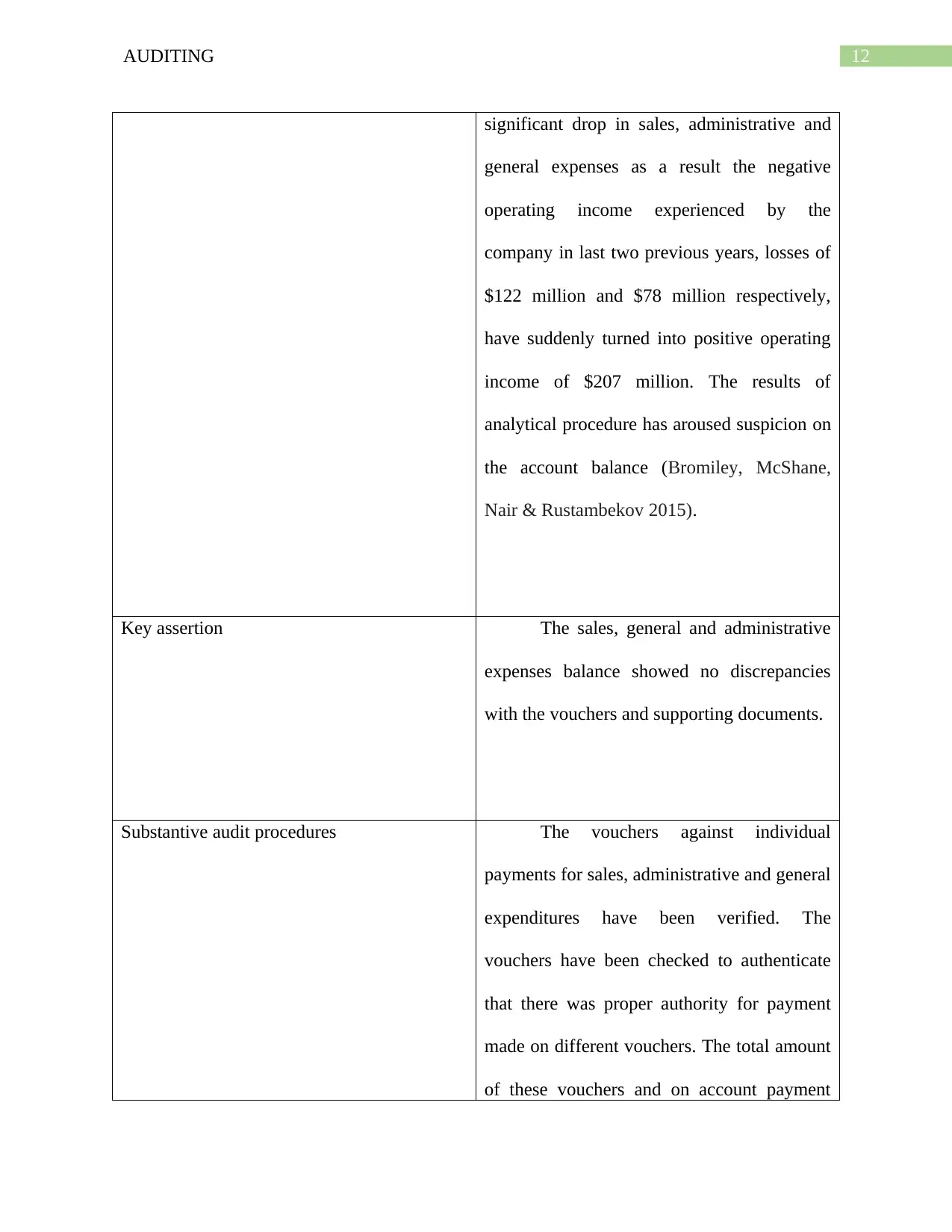
significant drop in sales, administrative and
general expenses as a result the negative
operating income experienced by the
company in last two previous years, losses of
$122 million and $78 million respectively,
have suddenly turned into positive operating
income of $207 million. The results of
analytical procedure has aroused suspicion on
the account balance (Bromiley, McShane,
Nair & Rustambekov 2015).
Key assertion The sales, general and administrative
expenses balance showed no discrepancies
with the vouchers and supporting documents.
Substantive audit procedures The vouchers against individual
payments for sales, administrative and general
expenditures have been verified. The
vouchers have been checked to authenticate
that there was proper authority for payment
made on different vouchers. The total amount
of these vouchers and on account payment
Paraphrase This Document
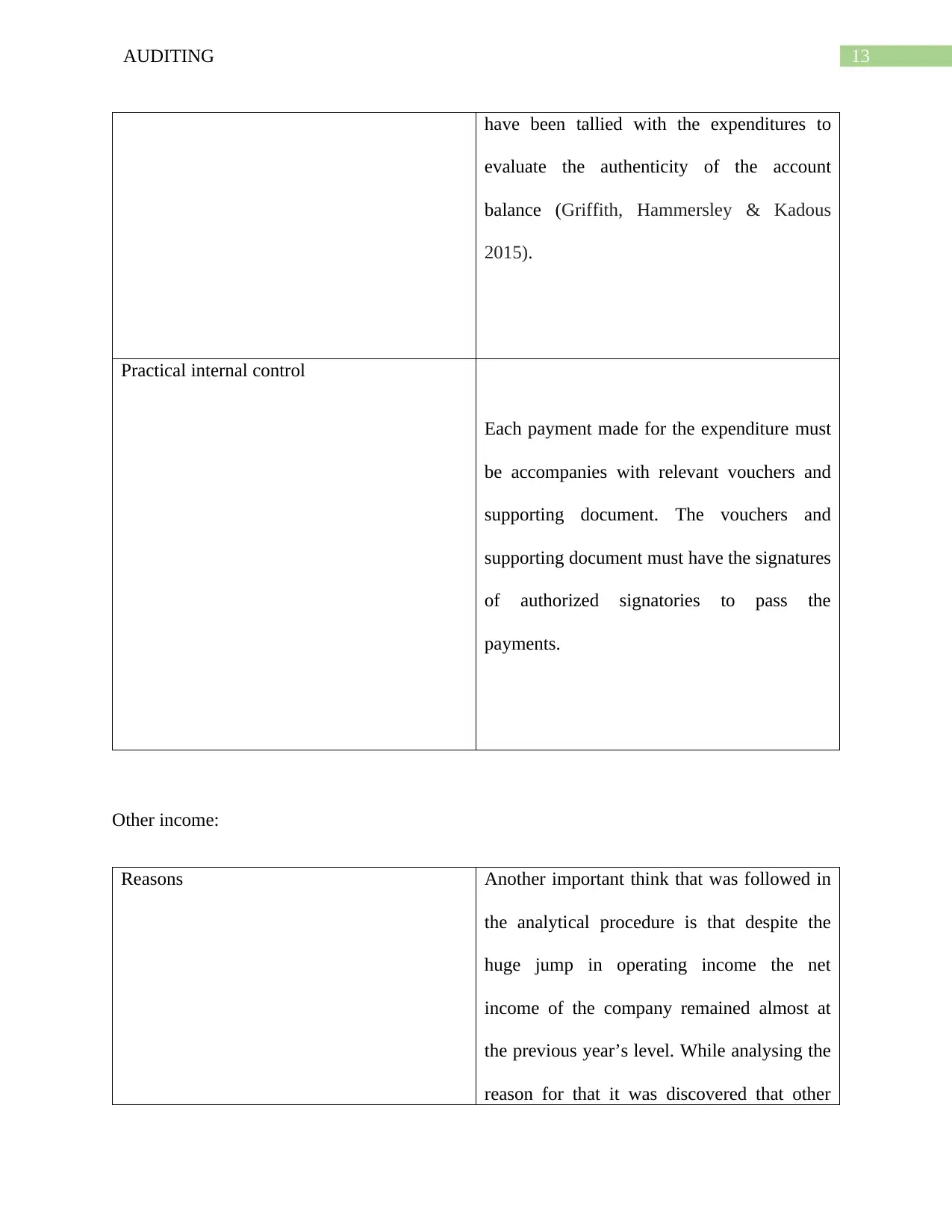
have been tallied with the expenditures to
evaluate the authenticity of the account
balance (Griffith, Hammersley & Kadous
2015).
Practical internal control
Each payment made for the expenditure must
be accompanies with relevant vouchers and
supporting document. The vouchers and
supporting document must have the signatures
of authorized signatories to pass the
payments.
Other income:
Reasons Another important think that was followed in
the analytical procedure is that despite the
huge jump in operating income the net
income of the company remained almost at
the previous year’s level. While analysing the
reason for that it was discovered that other
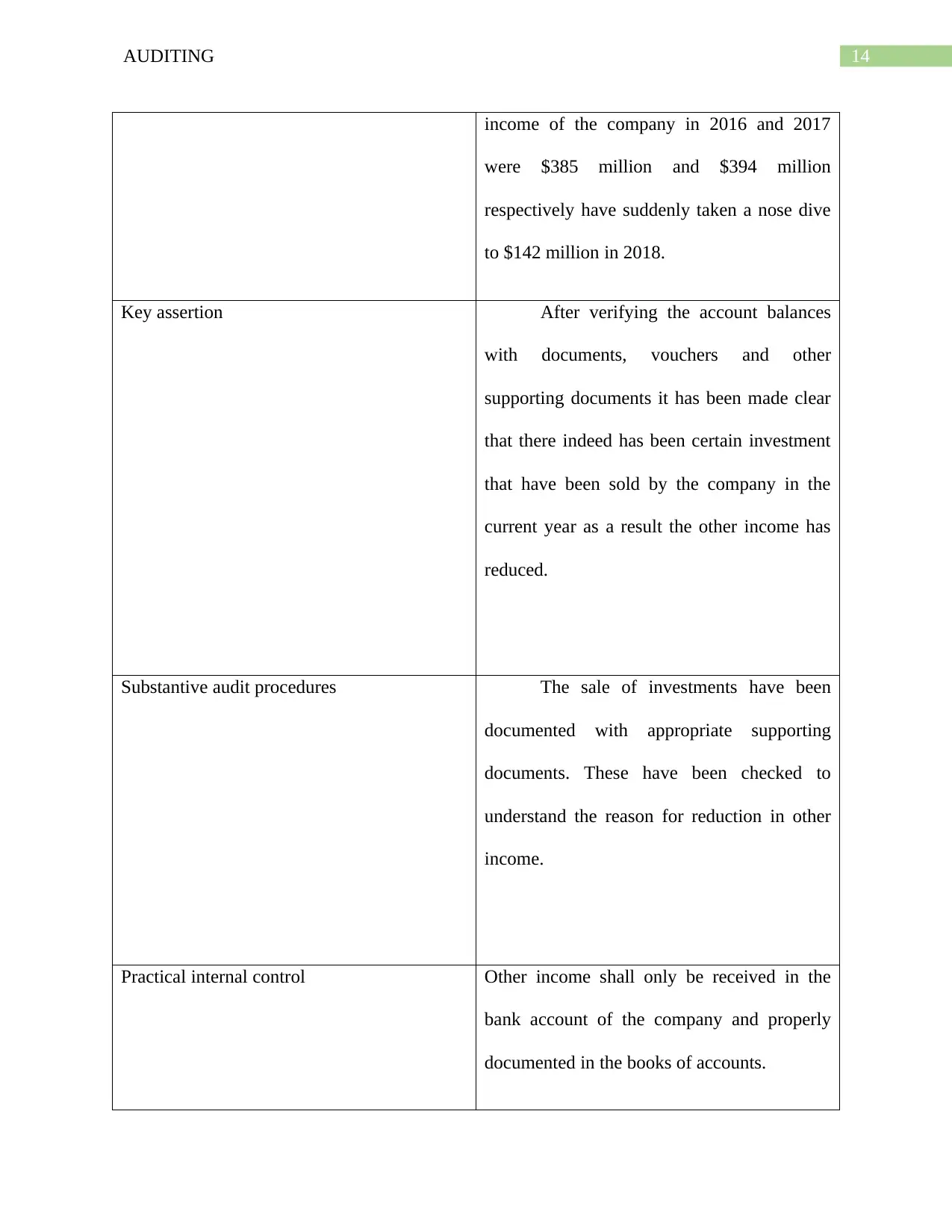
income of the company in 2016 and 2017
were $385 million and $394 million
respectively have suddenly taken a nose dive
to $142 million in 2018.
Key assertion After verifying the account balances
with documents, vouchers and other
supporting documents it has been made clear
that there indeed has been certain investment
that have been sold by the company in the
current year as a result the other income has
reduced.
Substantive audit procedures The sale of investments have been
documented with appropriate supporting
documents. These have been checked to
understand the reason for reduction in other
income.
Practical internal control Other income shall only be received in the
bank account of the company and properly
documented in the books of accounts.
⊘ This is a preview!⊘
Do you want full access?
Subscribe today to unlock all pages.

Trusted by 1+ million students worldwide
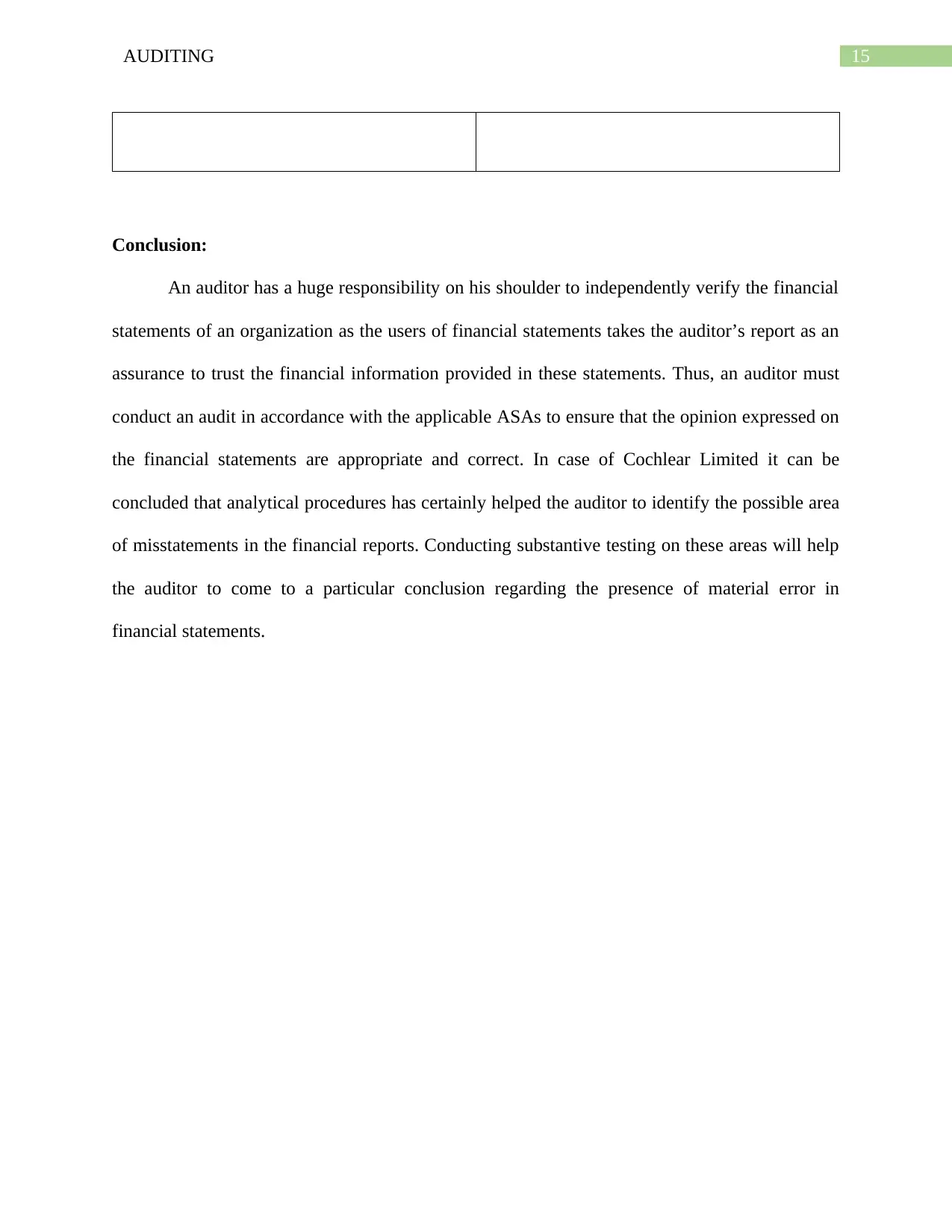
Conclusion:
An auditor has a huge responsibility on his shoulder to independently verify the financial
statements of an organization as the users of financial statements takes the auditor’s report as an
assurance to trust the financial information provided in these statements. Thus, an auditor must
conduct an audit in accordance with the applicable ASAs to ensure that the opinion expressed on
the financial statements are appropriate and correct. In case of Cochlear Limited it can be
concluded that analytical procedures has certainly helped the auditor to identify the possible area
of misstatements in the financial reports. Conducting substantive testing on these areas will help
the auditor to come to a particular conclusion regarding the presence of material error in
financial statements.
Paraphrase This Document
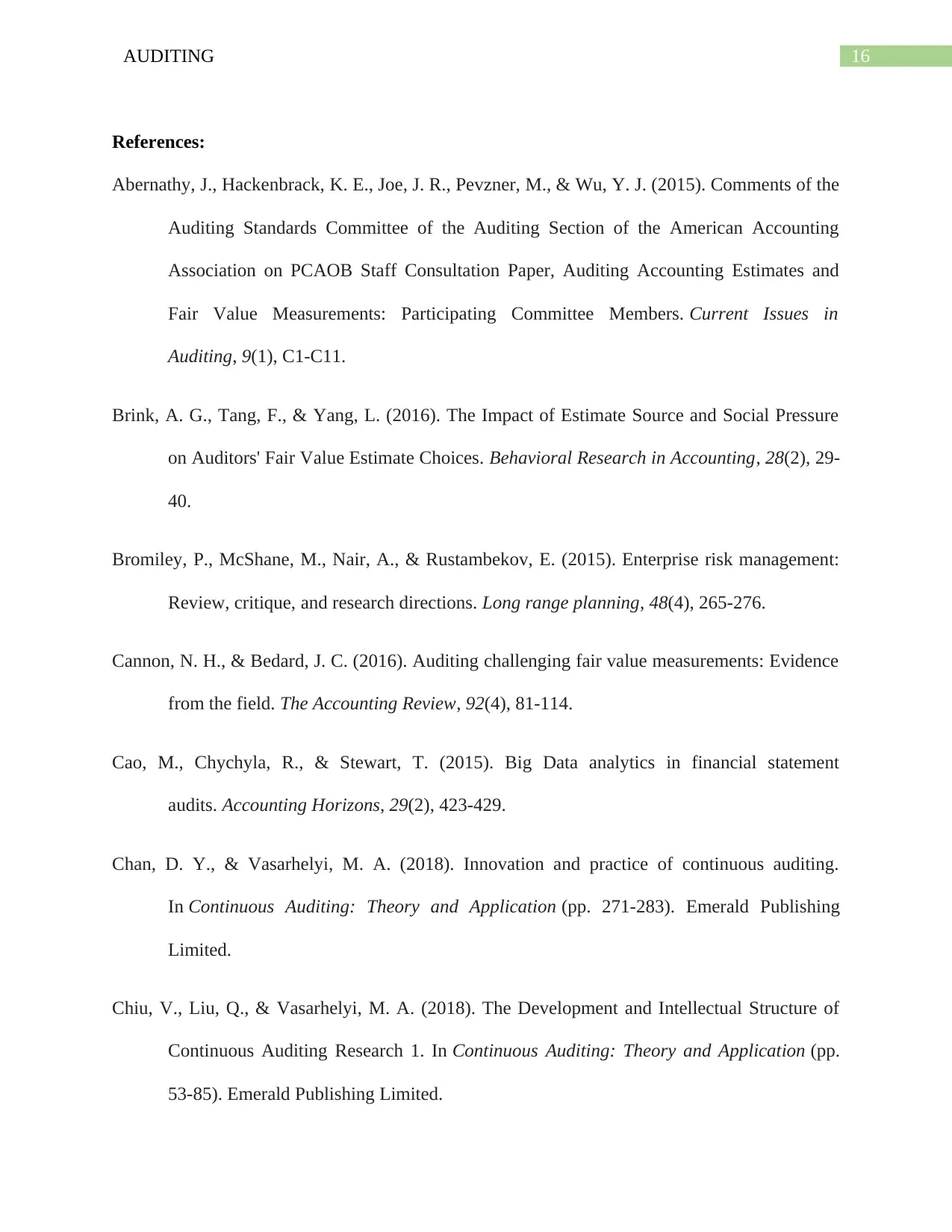
References:
Abernathy, J., Hackenbrack, K. E., Joe, J. R., Pevzner, M., & Wu, Y. J. (2015). Comments of the
Auditing Standards Committee of the Auditing Section of the American Accounting
Association on PCAOB Staff Consultation Paper, Auditing Accounting Estimates and
Fair Value Measurements: Participating Committee Members. Current Issues in
Auditing, 9(1), C1-C11.
Brink, A. G., Tang, F., & Yang, L. (2016). The Impact of Estimate Source and Social Pressure
on Auditors' Fair Value Estimate Choices. Behavioral Research in Accounting, 28(2), 29-
40.
Bromiley, P., McShane, M., Nair, A., & Rustambekov, E. (2015). Enterprise risk management:
Review, critique, and research directions. Long range planning, 48(4), 265-276.
Cannon, N. H., & Bedard, J. C. (2016). Auditing challenging fair value measurements: Evidence
from the field. The Accounting Review, 92(4), 81-114.
Cao, M., Chychyla, R., & Stewart, T. (2015). Big Data analytics in financial statement
audits. Accounting Horizons, 29(2), 423-429.
Chan, D. Y., & Vasarhelyi, M. A. (2018). Innovation and practice of continuous auditing.
In Continuous Auditing: Theory and Application (pp. 271-283). Emerald Publishing
Limited.
Chiu, V., Liu, Q., & Vasarhelyi, M. A. (2018). The Development and Intellectual Structure of
Continuous Auditing Research 1. In Continuous Auditing: Theory and Application (pp.
53-85). Emerald Publishing Limited.
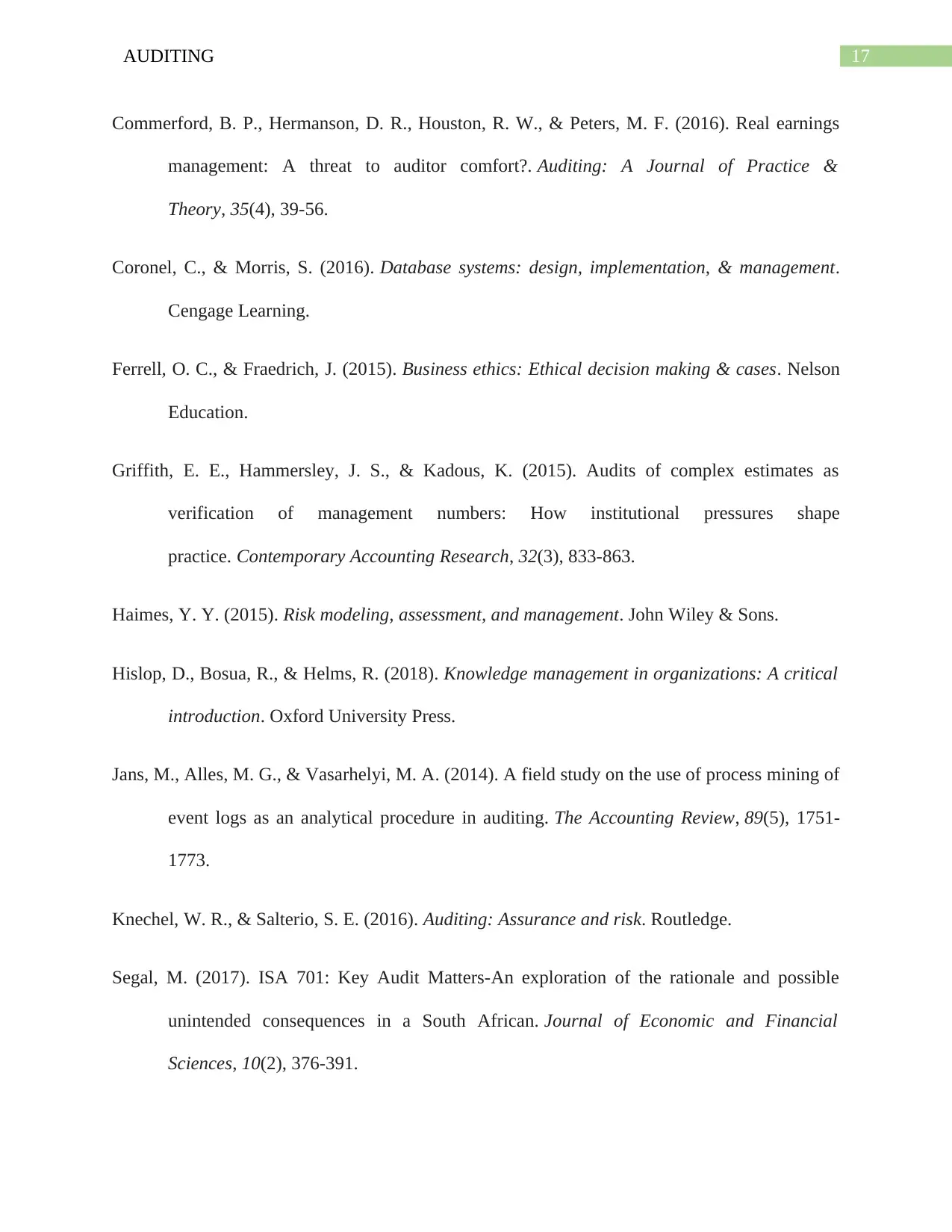
Commerford, B. P., Hermanson, D. R., Houston, R. W., & Peters, M. F. (2016). Real earnings
management: A threat to auditor comfort?. Auditing: A Journal of Practice &
Theory, 35(4), 39-56.
Coronel, C., & Morris, S. (2016). Database systems: design, implementation, & management.
Cengage Learning.
Ferrell, O. C., & Fraedrich, J. (2015). Business ethics: Ethical decision making & cases. Nelson
Education.
Griffith, E. E., Hammersley, J. S., & Kadous, K. (2015). Audits of complex estimates as
verification of management numbers: How institutional pressures shape
practice. Contemporary Accounting Research, 32(3), 833-863.
Haimes, Y. Y. (2015). Risk modeling, assessment, and management. John Wiley & Sons.
Hislop, D., Bosua, R., & Helms, R. (2018). Knowledge management in organizations: A critical
introduction. Oxford University Press.
Jans, M., Alles, M. G., & Vasarhelyi, M. A. (2014). A field study on the use of process mining of
event logs as an analytical procedure in auditing. The Accounting Review, 89(5), 1751-
1773.
Knechel, W. R., & Salterio, S. E. (2016). Auditing: Assurance and risk. Routledge.
Segal, M. (2017). ISA 701: Key Audit Matters-An exploration of the rationale and possible
unintended consequences in a South African. Journal of Economic and Financial
Sciences, 10(2), 376-391.
⊘ This is a preview!⊘
Do you want full access?
Subscribe today to unlock all pages.

Trusted by 1+ million students worldwide
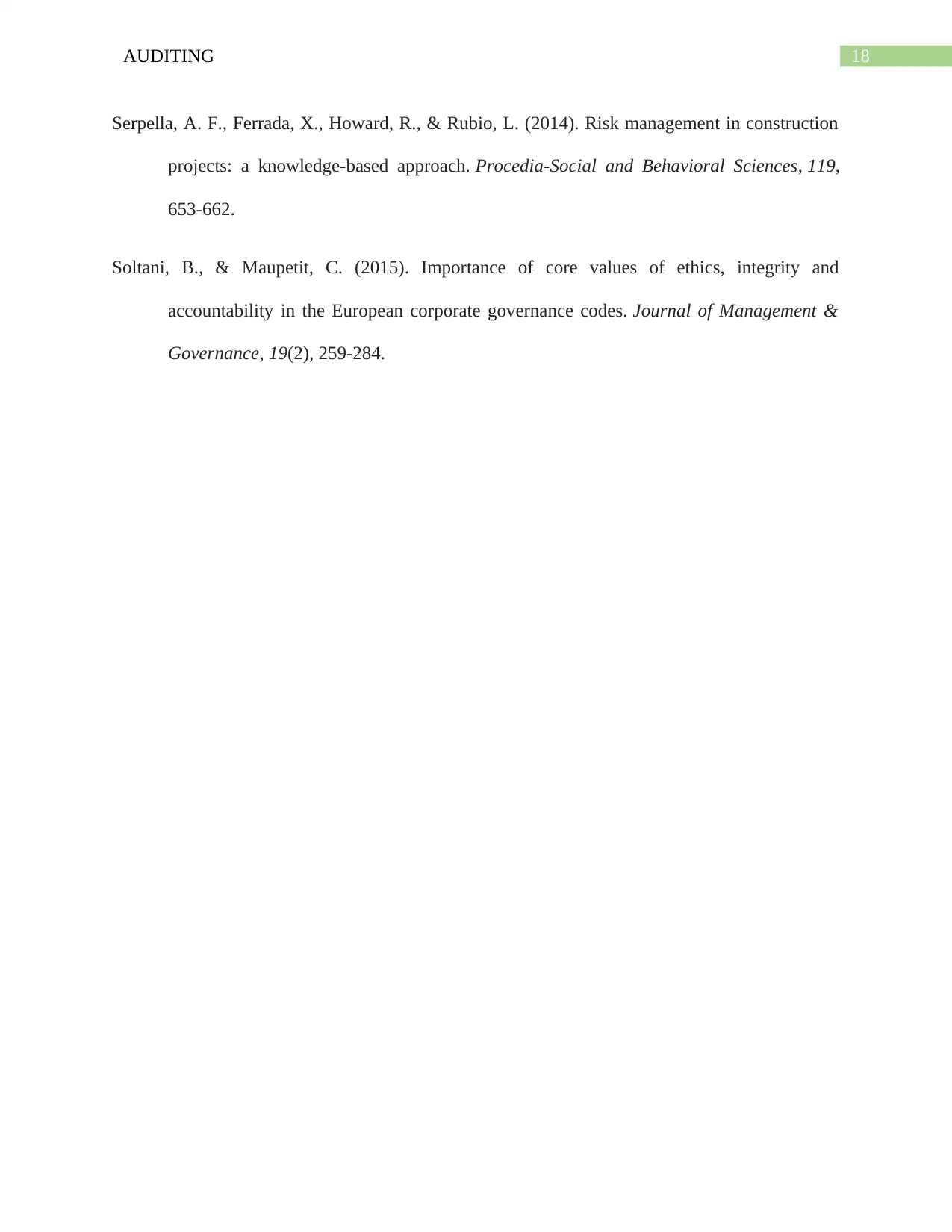
Serpella, A. F., Ferrada, X., Howard, R., & Rubio, L. (2014). Risk management in construction
projects: a knowledge-based approach. Procedia-Social and Behavioral Sciences, 119,
653-662.
Soltani, B., & Maupetit, C. (2015). Importance of core values of ethics, integrity and
accountability in the European corporate governance codes. Journal of Management &
Governance, 19(2), 259-284.
Paraphrase This Document
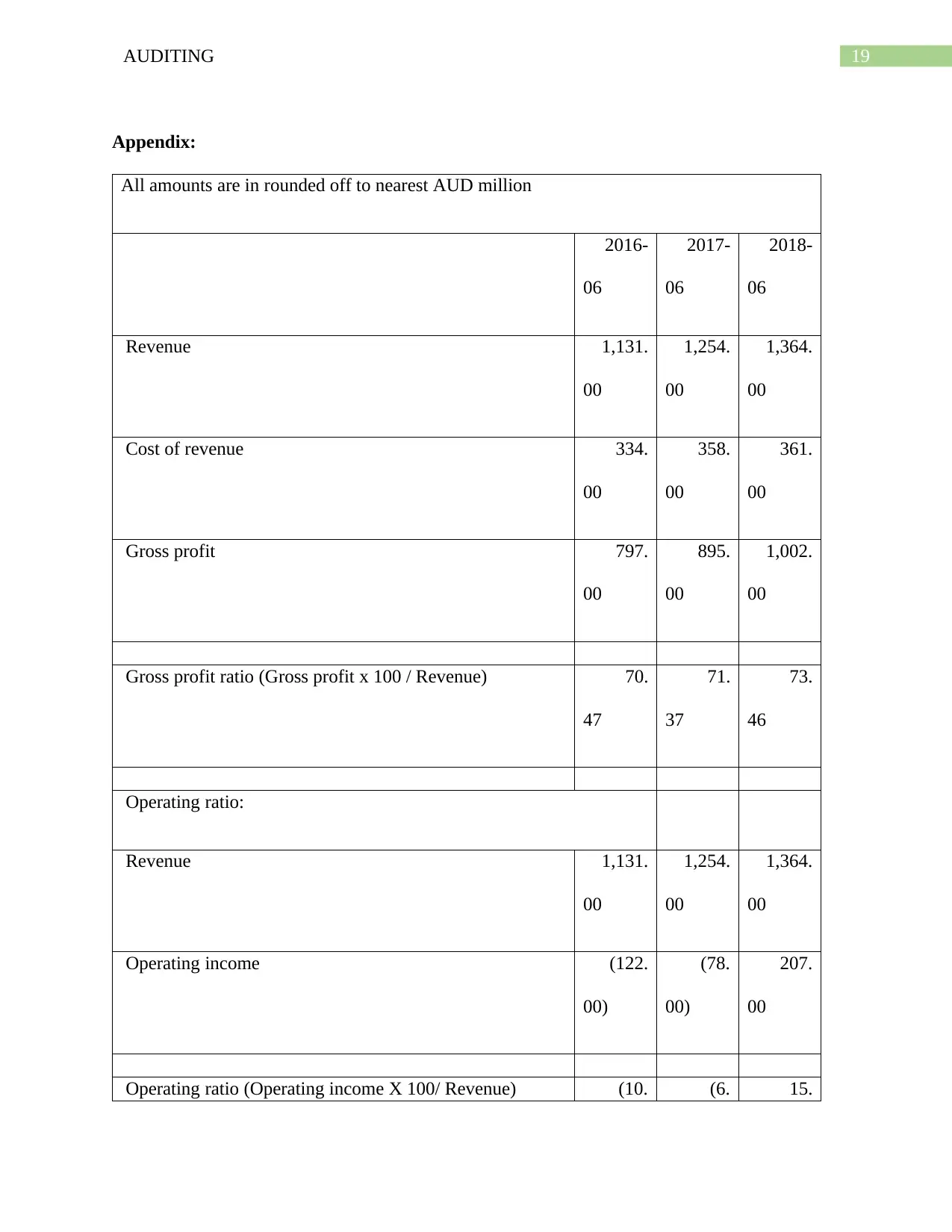
Appendix:
All amounts are in rounded off to nearest AUD million
2016-
06
2017-
06
2018-
06
Revenue 1,131.
00
1,254.
00
1,364.
00
Cost of revenue 334.
00
358.
00
361.
00
Gross profit 797.
00
895.
00
1,002.
00
Gross profit ratio (Gross profit x 100 / Revenue) 70.
47
71.
37
73.
46
Operating ratio:
Revenue 1,131.
00
1,254.
00
1,364.
00
Operating income (122.
00)
(78.
00)
207.
00
Operating ratio (Operating income X 100/ Revenue) (10. (6. 15.
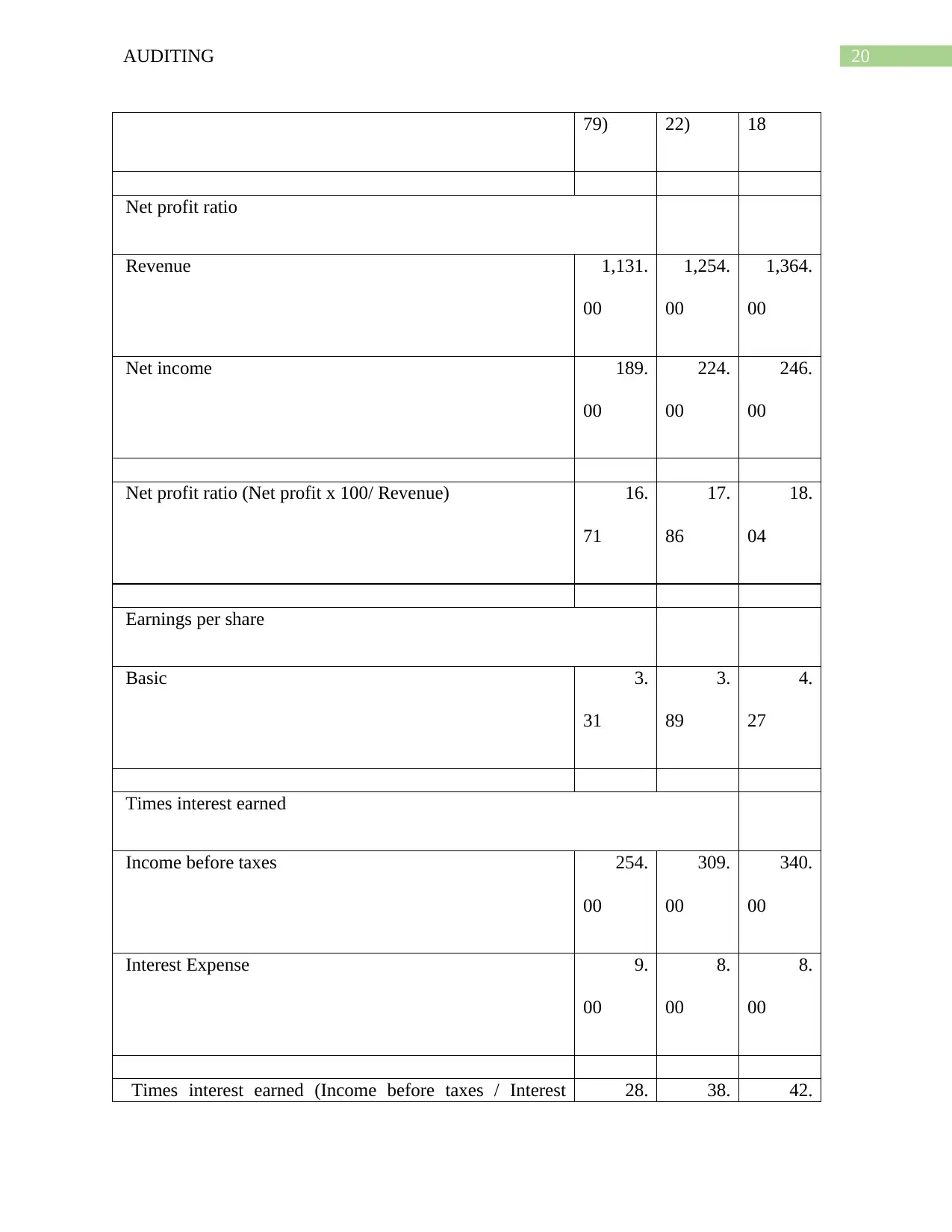
79) 22) 18
Net profit ratio
Revenue 1,131.
00
1,254.
00
1,364.
00
Net income 189.
00
224.
00
246.
00
Net profit ratio (Net profit x 100/ Revenue) 16.
71
17.
86
18.
04
Earnings per share
Basic 3.
31
3.
89
4.
27
Times interest earned
Income before taxes 254.
00
309.
00
340.
00
Interest Expense 9.
00
8.
00
8.
00
Times interest earned (Income before taxes / Interest 28. 38. 42.
⊘ This is a preview!⊘
Do you want full access?
Subscribe today to unlock all pages.

Trusted by 1+ million students worldwide
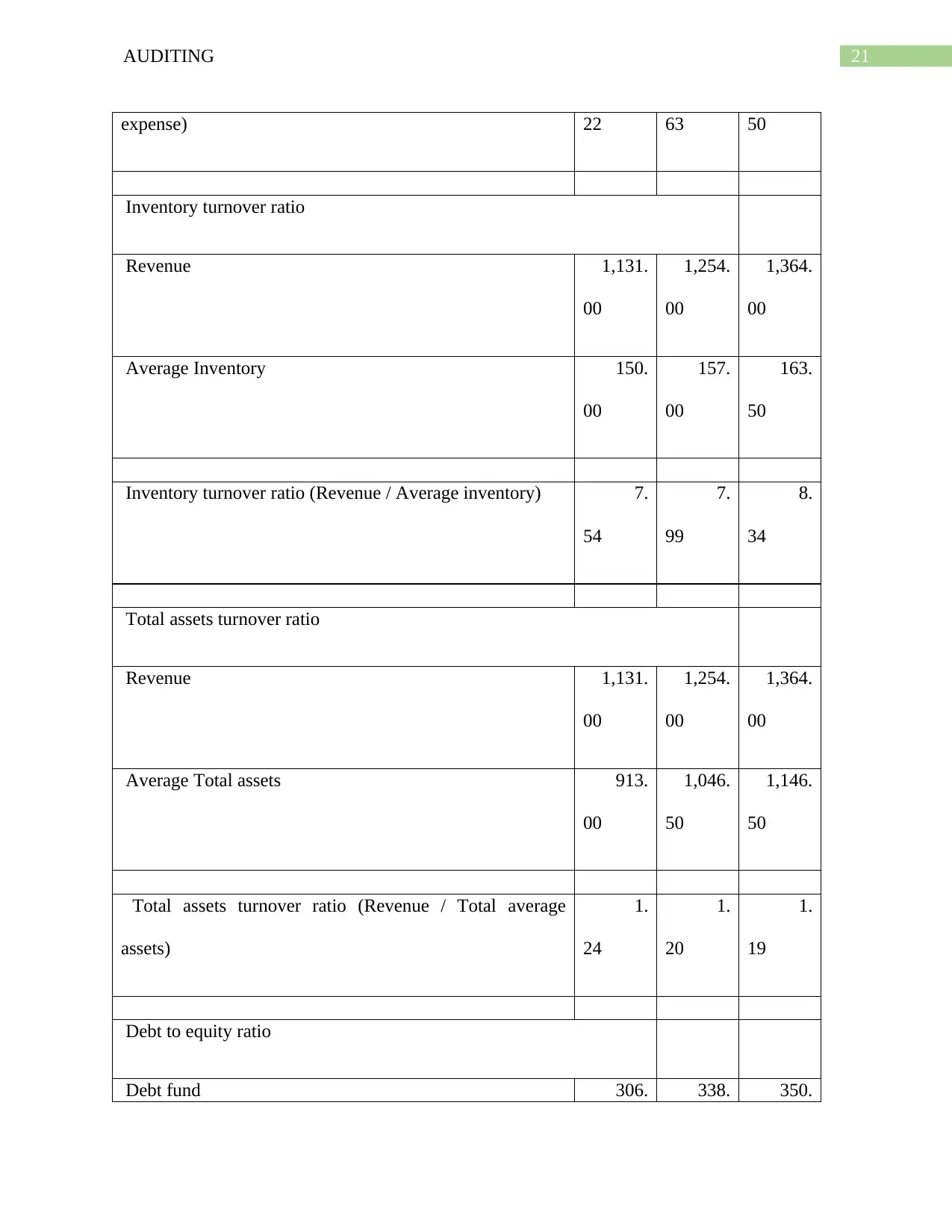
expense) 22 63 50
Inventory turnover ratio
Revenue 1,131.
00
1,254.
00
1,364.
00
Average Inventory 150.
00
157.
00
163.
50
Inventory turnover ratio (Revenue / Average inventory) 7.
54
7.
99
8.
34
Total assets turnover ratio
Revenue 1,131.
00
1,254.
00
1,364.
00
Average Total assets 913.
00
1,046.
50
1,146.
50
Total assets turnover ratio (Revenue / Total average
assets)
1.
24
1.
20
1.
19
Debt to equity ratio
Debt fund 306. 338. 350.
Paraphrase This Document
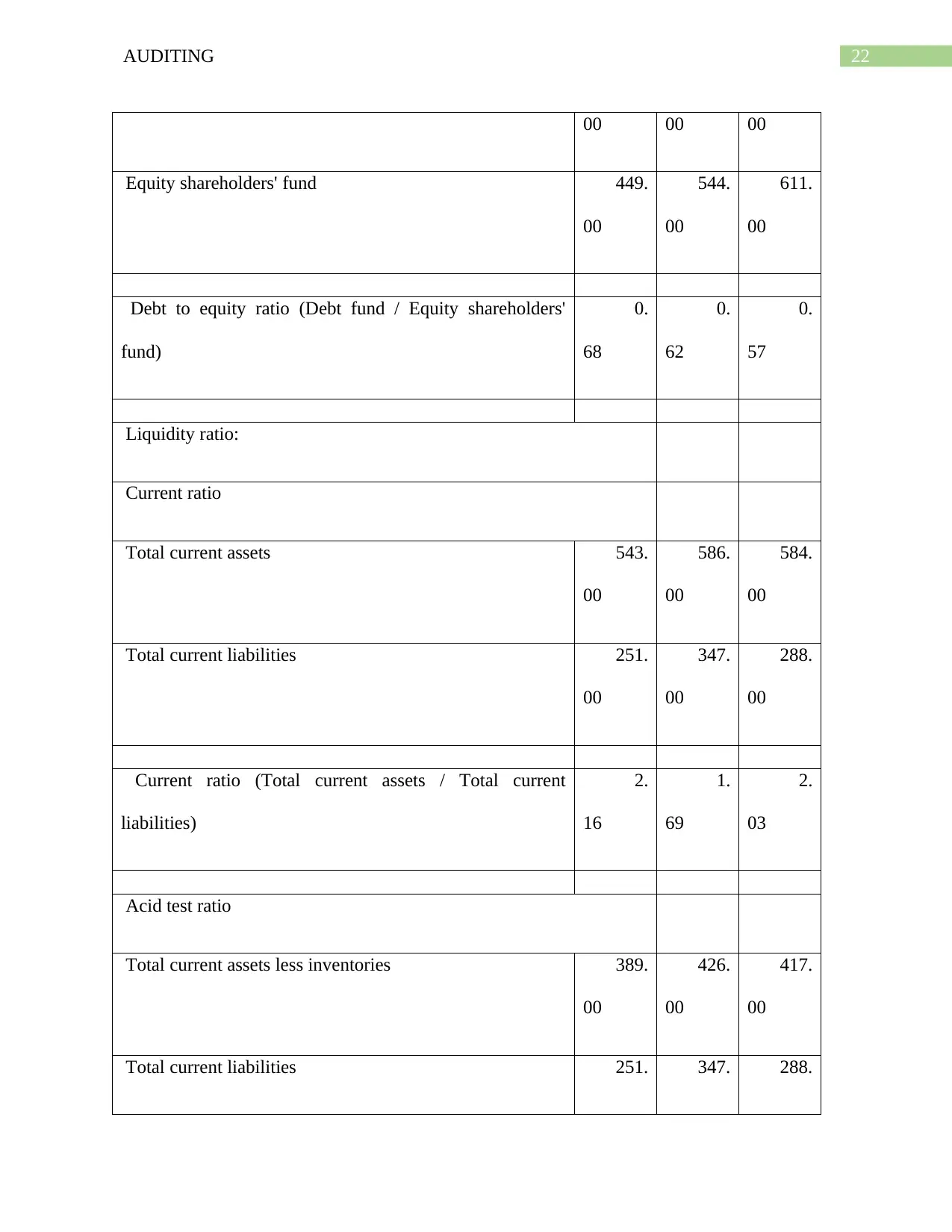
00 00 00
Equity shareholders' fund 449.
00
544.
00
611.
00
Debt to equity ratio (Debt fund / Equity shareholders'
fund)
0.
68
0.
62
0.
57
Liquidity ratio:
Current ratio
Total current assets 543.
00
586.
00
584.
00
Total current liabilities 251.
00
347.
00
288.
00
Current ratio (Total current assets / Total current
liabilities)
2.
16
1.
69
2.
03
Acid test ratio
Total current assets less inventories 389.
00
426.
00
417.
00
Total current liabilities 251. 347. 288.
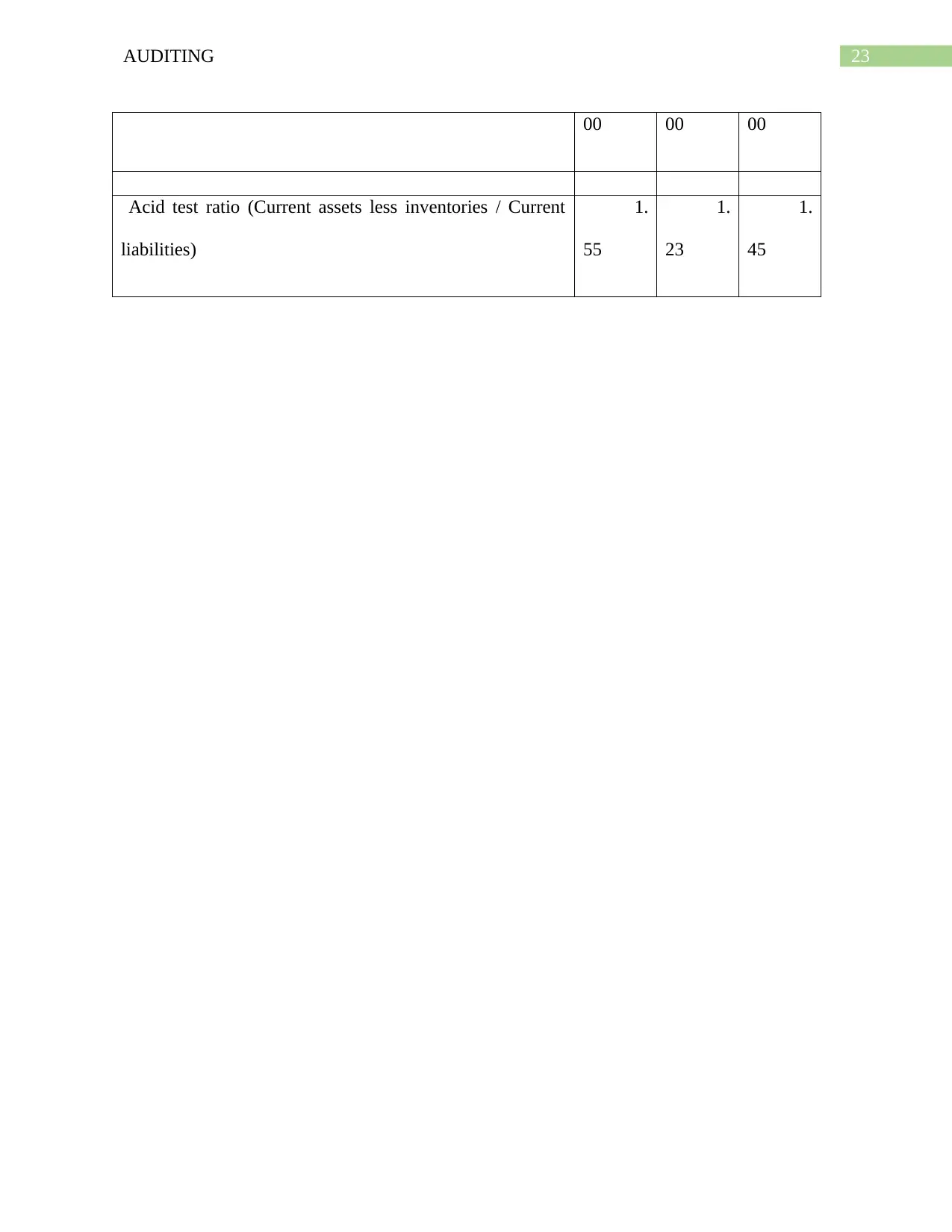
00 00 00
Acid test ratio (Current assets less inventories / Current
liabilities)
1.
55
1.
23
1.
45
⊘ This is a preview!⊘
Do you want full access?
Subscribe today to unlock all pages.

Trusted by 1+ million students worldwide
Related Documents
Your All-in-One AI-Powered Toolkit for Academic Success.
+13062052269
info@desklib.com
Available 24*7 on WhatsApp / Email
![[object Object]](/_next/static/media/star-bottom.7253800d.svg)
© 2024 | Zucol Services PVT LTD | All rights reserved.



